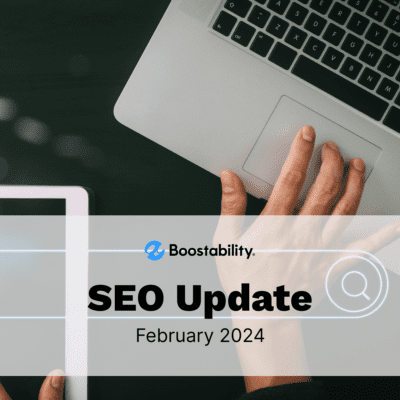This article was first published April 30th, 2020, and was last updated in January 2024.
In the past, we’ve written about the importance of content and how it can get your website ranking. In fact, good content is the #1 factor in ranking high on Google. It’s hard to overstate the importance of good content in the realm of SEO.
Content is the meat of your website. It’s the words on a page, videos, photos of products, and your blog. Content tells people why they should come to your business and website over your competition. Good content helps Google elevate your site in the rankings above your competition as well.
So, what do you need in your content in order to make your content effective? It’s so much more than just typing up a few words and product descriptions and waiting to see what happens. Here are 6 steps you can take to ensure your content is SEO–optimized. Let’s get started!
6 Steps to Creating Effective Content
1. Focus on Specific Keywords
There’s a fine balance between mentioning your target keywords several times throughout an article and completely keyword stuffing it. More often than not, keyword stuffing is obvious to your readers and to search engines. Either way, you lose. Don’t keyword stuff.
However, pick one or two important longtail keywords for every content piece, whether a blog or product description and use those strategically throughout the piece. These keywords help your customers understand more of what you do and help people discover your website. Keywords attract customers who are ready to buy and search for something very specific.
Longtail keywords increase your chances of reaching your target audience. It also gives you more ammunition to compete with your competitors as your keywords rise in the rankings.
For example, running shoes vs. women’s Asics running shoes. The first is a search by someone who wants to learn more. The second is someone who knows what they want and is trying to find it near them.
2. Add Meta Descriptions & Alt Text
In the SEO world, you hear the words Meta Description and Alt Text or Alt Tags all the time. But what are they? Tags are part of on-site optimization that is key to SEO.
Meta tags or Meta Descriptions tell the bots or crawlers from search engines what is on a specific page and how to treat it. Meta tags can summarize a piece of content that gives a generalization of the content. Readers can also use these to decide whether they want to proceed to read the entire article or not when it shows up in the SERPs. Meta descriptions can also reduce bounce rates.
Alt tags add text information to an image so search engines can still crawl and understand the image. It also helps those viewing the webpage to understand better what you’re saying.
Having meta descriptions and alt tags up your SEO game for content by 10-fold to make your website better compete in the SERPs and with your literal business competition.
3. Have Good Titles and Header Text
In just about every document that you’ve created content for, you see Heading 1, Title, Heading 2, Paragraph, and what seems like a dozen other options. But does it really matter which one you pick?
In a word, YES! Giving your content a good title and keyword–rich Heading 1 (H1) is crucial in the world of SEO. The search engine bots crawl these items and are used to understand the content.
An H1 is an HTML code that signals bots that it’s an important part of the content they should crawl. That’s why it’s important to include a keyword that is most important to the article’s topic or the page in the H1. Just having an H1 on your page will, by itself, help that page start to rank better.
Having a good title and Headings also makes your content more user-friendly. This allows someone to quickly scan through the page and decide whether to read the whole thing. Good content isn’t just for search engines; it’s more important to ensure that it fits what your audience wants to read and helps them learn more about your business or area of expertise.
4. Use URL Structures
Have you ever thought about the URLs for your website and the blogs? Have you tried to be strategic about what the URL says? Being strategic about your URL for a blog piece can help your SEO and your user experience!
If you carefully construct your URL, it helps all parties involved understand what they will find if they click, especially if the title tag or meta description is unavailable.
For example, if your URL says something like boostability.com/hmshgilcs12/ (completely made up for the record) versus boostability.com/how-to-make-your-content-seo-ready/. See what I mean? The URL is easily crawlable by the search engines and easy to understand for readers.
Numbers are also only sometimes helpful in a URL. While listicles are great quality content for readers that give them actionable items they can do, they don’t do anything for a URL. In fact, it could hurt the crawlability of a web page because then the algorithm will only deliver that webpage if someone is specifically looking for 6 ways to optimize your content.
Before posting a blog or a new page to your website, take a second to make sure the URL is helpful and clear.
5. Include a Good Blog
Beyond the items talked about above, there are several things a blog absolutely should have in order to help it be SEO–ready.
Easy to Understand
This is crucial! You would not believe the amount of poorly written or hard-to-comprehend content that exists on the internet! Whether it’s an image caption or a full-blown blog post, make sure that it makes sense, that your audience will be able to understand the point of it, and that it flows well from point to point.
Credible & Relevant
Credibility goes a long way with your website visitors. Your website is the place to show why you’re the best at what you do. It’s how you show off your skillset and demonstrate that you can solve the problems your customers face. But your content also needs to be relevant.
Stay in your lane and demonstrate your expertise. Good content is relevant to the time frame, business goals, and the customers’ current needs.
Connect With People’s Emotions and Needs
There’s a phrase used in the journalism world: People fascinate people. We love to read the stories of others that tug on our heartstrings. Or that tell great stories that people can relate to. While not every piece of content needs to have an emotional tie, bringing that in from time to time can help people connect with your business.
Don’t Be Afraid to Get Deep!
Long-form content does well when it comes to search engine rankings, and for readers. In-depth blogs that get into the nitty-gritty of a topic (this one, for example) can really benefit your customers and your website.
These types of long-form articles truly demonstrate your expertise. It gives people actionable insights they can take to help themselves. And it establishes you as a leader in your industry and business niche.
There are a lot of types of content you can write on your blog. You can write a thought leadership-type piece that shows why you’re an expert in your field.
Write a how-to article or a listicle. Or, you can write about news in your industry and how it applies to your area. There are so many different kinds of content you can write!
6. Keep Your Audience in Mind
It’s important to have content creation for your customers, potential customers, and community. Essentially, you’re writing for people. You’re not writing specifically for the search engines to rank you higher. But by doing all of these things listed above, good content will also get the attention of the search engines.
Of course, this is a partial list of all SEO tasks you can do to optimize your content. But these items will help boost your content higher than just writing a blog or adding a photo to your website without giving it any help. Take these steps and start to watch your content grow!
Creating Effective Content with Boostability!
For your clients, it’s important to partner with a white label SEO agency that knows what they’re doing with content marketing strategies and how to rank for certain keywords. If you’re looking for a partnership and need help with your SEO keyword strategy, Boostability is here to help! Get started with our Partner Program today!










